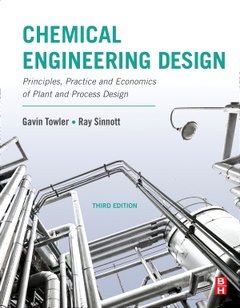Description
Chemical Engineering Design (3rd Ed.)
Principles, Practice and Economics of Plant and Process Design
Authors: Towler Gavin, Sinnott Ray
Language: English
Subject for Chemical Engineering Design:
Keywords
design factors; optimization; stoichiometry; system boundary; yield; recycle processes; energy balance; mean heat capacities; enthalpy; energy recovery; heat-exchanger; piping systems; instrumentation; compressors; material properties; corrosion resistance; hazards; reactors; gas separations; distillation; pressure vessels
1040 p. · 21.5x27.6 cm · Paperback
Description
/li>Contents
/li>Biography
/li>Comment
/li>
Part I: Process Design 1. Introduction to Design 2. Process Flowsheet Development 3. Utilities and Energy Efficient Design 4. Process Simulation 5. Instrumentation and Process Control 6. Materials of Construction 7. Capital Cost Estimating 8. Estimating Revenues and Production Costs 9. Economic Evaluation of Projects 10. Safety and Loss Prevention 11. General Site Considerations 12. Optimization in Design
Part II: Plant Design 13. Equipment Selection, Specification and Design 14. Design of Pressure Vessels 15. Design of Reactors and Mixers 16. Separation of Fluids 17. Separation Columns (Distillation, Absorption and Extraction) 18. Specification and Design of Solids-Handling Equipment 19. Heat Transfer Equipment 20. Transport and Storage of Fluids
Gavin has 20 years of broad experience of process and product design and has 65 US patents. He is co-author of “Chemical Engineering Design, a textbook on process design, and is an Adjunct Professor at Northwestern University, where he teaches the senior design classes.
Gavin has a B.A. and M.Eng. in chemical engineering from Cambridge University and a Ph.D. from U.C. Berkeley. He is a Chartered Engineer and Fellow of the Institute of Chemical Engineers, and is a Fellow of the AIChE.
Ray Sinnott's varied career, mainly in design and development, began with several major companies including Dupont and John Brown. The main areas covered within these appointments were: Gas Production and Distribution, Nuclear Energy, Elastomers and Textile fibres.
After his career in industry he joined the Chemical Engineering Department, University of Wales Swansea in 1970, specialising in teaching process and plant design, and other engineering practice subjects.
The first edition of Chemical Engineering Design (Coulson and Richardson’s Vol 6) was published in 1983. Subsequent editions have been published at approximately 5 year intervals.
Ray Sinnott retired from full time teaching in 1995 but has maintained close contact with the engineering profession.
- Provides students with a text of unmatched relevance for chemical process and plant design courses and for the final year capstone design course
- Written by practicing design engineers with extensive undergraduate teaching experience
- Contains more than 100 typical industrial design projects drawn from a diverse range of process industries
NEW TO THIS EDITION
- Includes new content covering food, pharmaceutical and biological processes and commonly used unit operations
- Provides updates on plant and equipment costs, regulations and technical standards
- Includes limited online access for students to Cost Engineering’s Cleopatra Enterprise cost estimating software




